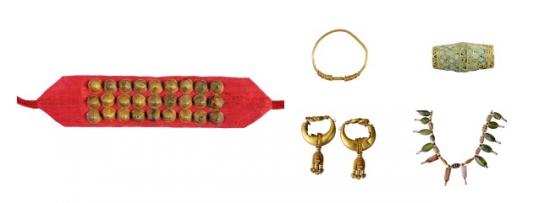Gargi Gupta
Source - http://www.dnaindia.com/lifestyle/report-piecing-together-an-ornamental-past-2039573
A 5,000-year-old necklace on display at the National Museum represents not just the fine aesthetics of the Indus Valley Civilisation, but also a continuum of design from then till now, says Gargi Gupta

Intricate gold ring, also from Sirkap
Some may dismiss jewellery as mere knick-knacks for women. But ornaments, like art, architecture, coins or pottery, are historical and cultural artefacts too, telling stories about a society and a civilisation, its moral codes, design ethic and even technological prowess.
Going by the jewellery they made and wore, the ancient people of the Indus Valley Civilisation were an extremely sophisticated lot with a finely-developed aesthetic sense, backed by intricate engineering skills. Take for instance the necklace excavated from Mohenjo-daro now on display at the newly re-opened jewellery gallery of the National Museum in Delhi.
The necklace, dating nearly 5,000 years ago, is lined with pendants of banded agate and jade beads suspended by a thick gold wire that passes through each bead. "These are very long beads, and when we examined them under the microscope, we found that they had been drilled perfectly to meet in the middle," says jewellery historian Usha Balakrishnan, who has curated the collection.
"India was the largest manufacturer and exporter of beads to the world at that time," she adds. The craftsmen of the Indus Valley used semi-precious material like carnelian, agate, turquoise, faience, steatite and feldspar, fashioning them into tubular or barrel shapes, decorating them with carvings, bands, dots and patterns, or setting them minutely with gold."They had the skill of tumbling beads, of cutting semi-precious hardstones, of shaping the beads. India was also home to the diamond and invented the diamond drill, which was then taught to the Romans," says Balakrishnan.

A brooch from Harappa, Bracelet from Mohenjo-daro, Gold earrings from Taxila & Gold bracelet, Sirkap
But it's not just technological prowess that one marvels at. What's also remarkable is the continuity of design. The sheet gold forehead ornament, for instance, is of a shape that you will find women still wearing in different parts of India. The Rajasthani borla is a close approximation, as is the ornament that Didarganj Yakshi, one of the finest examples of ancient Indian sculpture, wears prominently in the middle of her forehead.
Indus Valley ornaments are among the few specimens of jewellery that have survived in our times. Most others have either been recycled, melted for gold, or lost to the many invaders. This also explains the large gaps in the gallery collection — the next specimens come from Sirkap, an Indo-Greek city near Taxila in present-day Pakistan, dating to about the first century AD.
In the 2,000 years from Mohenjo-daro to Sirkap, the craftsman had polished his skills immensely. So there's delicate filigree work on gold and embossing work. The microgranulations on the pendants of a pair of large earrings are so fine that each is about the size of a grain of sand.
Another interesting piece consists of two square amulets embossed with the image of the swastika — "the earliest known representations of swastika in gold known to us," says Balakrishnan. But the swastika is not the only icon found among the Sirkap ornaments that we find repeated through the history of southeast Asia. There are also the lion and fish motifs, and the 'poorna ghat' or the vase of plenty that we even now place symbolically at the start of a puja.
Large parts of the history of ancient India, especially the Indus Valley Civilisation, are shrouded in obscurity. The jewellery of the era, by giving a sense of how women of the era adorned themselves and how society at the time was geared towards providing them those adornments, helps to lift the darkness a little.